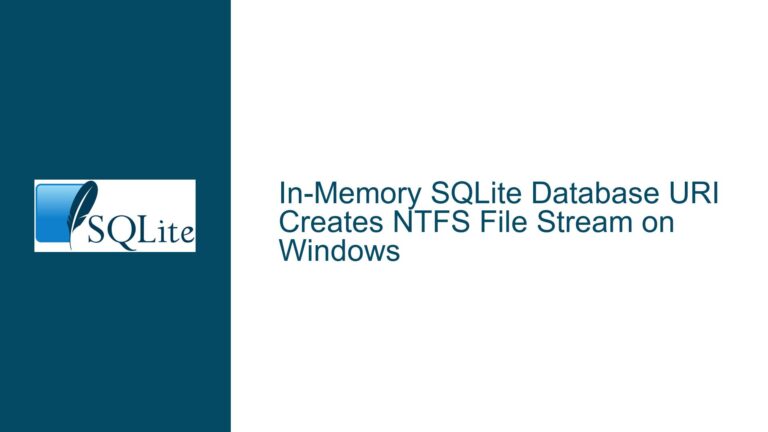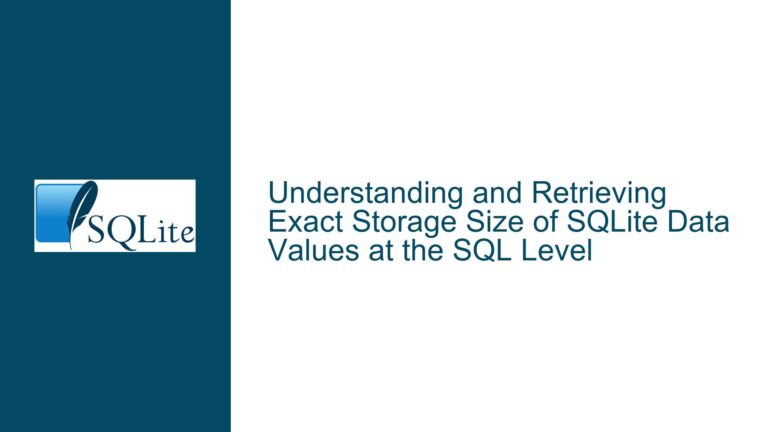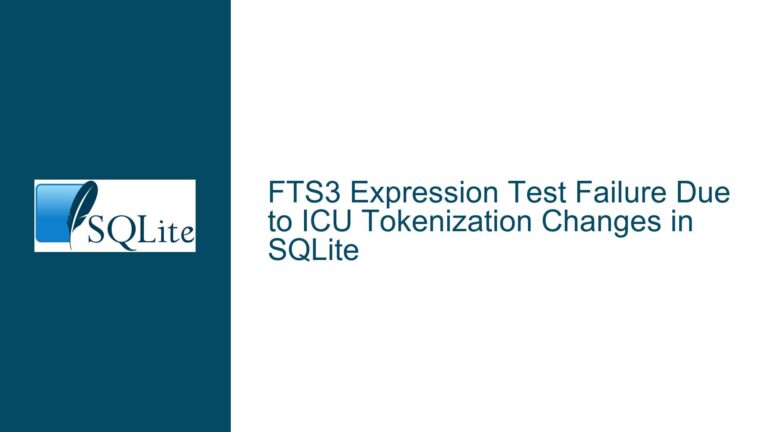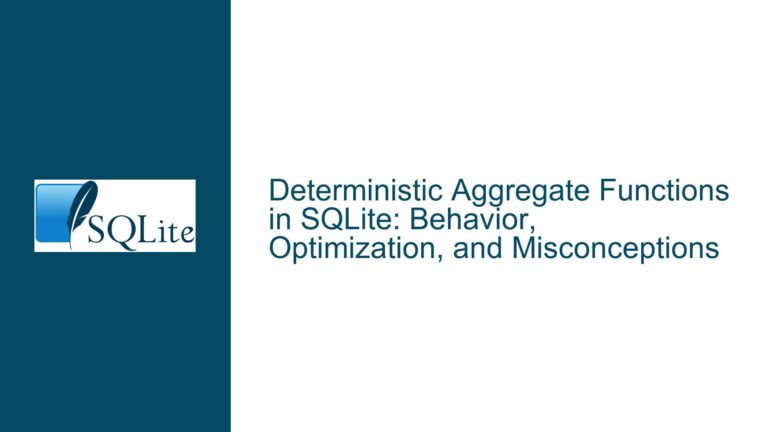Managing Transaction State and Locking Behavior After Savepoint Rollbacks in SQLite
Transaction Lifecycle Conflicts After Savepoint Rollbacks
The core issue revolves around SQLite’s handling of transaction states following the use of ROLLBACK TO on a savepoint. When a savepoint is rolled back, SQLite does not automatically terminate the transaction or reset the autocommit state. This behavior can lead to unintended consequences, such as prolonged database locks or implicit transaction retention, which disrupts subsequent operations expecting autocommit mode. For example, after rolling back to a savepoint, a subsequent SELECT statement may inadvertently retain a SHARED LOCK on the database, blocking concurrent write operations. This occurs because the outer transaction remains active even after the savepoint is rolled back. The problem is particularly pronounced in nested transactional workflows, where functions or modules assume autocommit is active after handling errors via savepoints.
A critical nuance lies in SQLite’s default autocommit behavior. When no explicit transaction is active, SQLite operates in autocommit mode: each statement runs in its own transaction, committing immediately. However, when an explicit transaction (e.g., BEGIN, SAVEPOINT) is started, autocommit is suspended until the transaction is explicitly committed or rolled back. The ROLLBACK TO command only rewinds the transaction timeline to the state captured by the savepoint—it does not release the savepoint or terminate the outer transaction. This leaves the database in an ambiguous state where the application may erroneously assume autocommit has resumed, leading to locking conflicts and concurrency issues.
The original proposal sought to extend the ROLLBACK TO syntax with an AUTOCOMMIT modifier to conditionally terminate the outer transaction. However, this approach conflates two distinct operations: rolling back to a savepoint and terminating the transaction. The root problem is not the absence of an autocommit flag but the retention of the outer transaction after a savepoint rollback. Misunderstanding this distinction can lead to flawed application logic, where subsequent database operations inherit unintended transactional contexts.
Misaligned Savepoint Management and Implicit Transaction Retention
The primary cause of transaction state conflicts lies in improper savepoint lifecycle management. Savepoints are markers within a transaction timeline, allowing partial rollbacks without affecting the entire transaction. However, rolling back to a savepoint does not automatically release it. Failing to explicitly RELEASE the savepoint after a rollback leaves the transaction open, as the outer transaction context persists. This is exacerbated in nested workflows, where functions create savepoints but do not account for the broader transactional context.
A second cause is the assumption that rolling back to a savepoint resets the autocommit state. SQLite’s autocommit mode is strictly tied to the presence of an active transaction. If a savepoint is created without an enclosing BEGIN, the outermost transaction is implicit. Rolling back to this savepoint does not terminate the implicit transaction; it merely resets the database state. Applications expecting autocommit to resume will instead continue operating within the implicit transaction, leading to unexpected locks.
A third factor is the lack of atomicity in error-handling routines. When a function creates a savepoint, performs operations, and rolls back on error, it must ensure the savepoint is released to avoid leaving the transaction open. For example, a function that executes SAVEPOINT X, encounters an error, and runs ROLLBACK TO X but omits RELEASE X will leave the transaction active. Subsequent statements outside the function will inherit this transaction, violating the principle of least astonishment.
Concurrency issues arise from prolonged SHARED locks held by open transactions. In SQLite, a SHARED lock is acquired when a read operation occurs within a transaction. If the transaction remains open, this lock prevents other processes from acquiring a RESERVED or EXCLUSIVE lock for writes. Functions that roll back to savepoints but fail to release them can thus degrade database concurrency, as even simple SELECT statements may retain locks indefinitely.
Structured Savepoint Handling and Transaction Boundary Enforcement
Step 1: Explicit Savepoint Release After Rollback
Always pair ROLLBACK TO with RELEASE to ensure the savepoint is erased from the transaction timeline. For example:
SAVEPOINT X;
-- ... operations ...
ROLLBACK TO X;
RELEASE X;
This guarantees that the savepoint is removed, and the transaction continues as if the savepoint never existed. If X was the outermost savepoint, RELEASE X effectively ends the transaction, resuming autocommit mode.
Step 2: Isolate Transactional Contexts in Nested Workflows
Functions that use savepoints should not assume control over the broader transactional state. Instead, they should accept a parameter indicating whether they are executing within an existing transaction. For example:
def execute_operation(db, in_transaction=False):
if not in_transaction:
db.execute("BEGIN")
try:
db.execute("SAVEPOINT X")
# ... operations ...
db.execute("RELEASE X")
if not in_transaction:
db.execute("COMMIT")
except Error:
db.execute("ROLLBACK TO X")
db.execute("RELEASE X")
if not in_transaction:
db.execute("ROLLBACK")
This pattern ensures that functions manage their savepoints without interfering with external transactional contexts.
Step 3: Monitor Transaction State Programmatically
Applications should explicitly check the transaction state before executing operations that assume autocommit. Use sqlite3_get_autocommit() (in C) or equivalent in other languages to detect active transactions. For example:
import sqlite3
conn = sqlite3.connect(":memory:")
print(conn.in_transaction) # False (autocommit active)
conn.execute("SAVEPOINT X")
print(conn.in_transaction) # True
conn.execute("ROLLBACK TO X")
print(conn.in_transaction) # True
conn.execute("RELEASE X")
print(conn.in_transaction) # False
This prevents logic errors by ensuring operations are aware of the current transactional state.
Step 4: Avoid Implicit Transactions with Explicit BEGIN/COMMIT
Relying on SQLite’s implicit transactions (autocommit mode) for write operations can lead to ambiguity. Instead, use explicit BEGIN and COMMIT statements to define transactional boundaries. This eliminates guesswork about whether a transaction is active:
BEGIN; -- Explicitly start transaction
SAVEPOINT X;
-- ... operations ...
ROLLBACK TO X;
RELEASE X;
COMMIT; -- Explicitly end transaction
Step 5: Leverage DEFERRED Transactions for Read-Heavy Workloads
When transactions are primarily read-only, use BEGIN DEFERRED to defer lock acquisition until the first write operation. This minimizes contention and ensures SHARED locks are held for the shortest possible duration:
BEGIN DEFERRED;
SAVEPOINT X;
SELECT * FROM table; -- Acquires SHARED lock
ROLLBACK TO X;
RELEASE X;
COMMIT; -- Releases SHARED lock immediately
Step 6: Design Error Handlers to Enforce Transaction Cleanup
Error handlers must ensure that all savepoints are released and transactions are terminated. A template for exception-safe code:
try:
db.execute("SAVEPOINT X")
# ... operations ...
db.execute("RELEASE X")
except DatabaseError:
db.execute("ROLLBACK TO X")
db.execute("RELEASE X")
# Optionally re-raise or handle the error
finally:
if not in_transaction:
db.execute("COMMIT" if success else "ROLLBACK")
Step 7: Analyze Locking Behavior with SQLite Internals
Use SQLite’s sqlite3_step and sqlite3_prepare to trace lock acquisition in debug builds. Monitor the PENDING and SHARED lock states to identify prolonged holds caused by unclosed transactions. Tools like sqlite3_trace can log transactional operations, helping correlate lock retention with specific code paths.
Step 8: Educate Teams on Transactional Semantics
Misunderstanding the difference between ROLLBACK and ROLLBACK TO is a common pitfall. Training materials should emphasize:
ROLLBACKterminates the entire transaction and resumes autocommit.ROLLBACK TOrewinds the transaction but leaves it active.RELEASEremoves the savepoint marker without committing/rolling back.
Step 9: Implement Integration Tests for Concurrency Scenarios
Automated tests should simulate concurrent read/write operations to verify that transactional logic does not inadvertently retain locks. For example:
- Process A starts a transaction, creates a savepoint, and rolls back.
- Process B attempts to write to the database.
- Assert that Process B does not encounter a
SQLITE_BUSYerror.
Step 10: Advocate for SQLite Configuration Best Practices
Configure SQLite with PRAGMA journal_mode=WAL; to allow concurrent reads and writes. While this does not resolve transactional state issues, it reduces contention by decoupling read and write locks.
By adhering to these practices, developers can avoid transactional state mismatches, ensure proper lock management, and maintain the concurrency benefits of SQLite’s autocommit mode.






